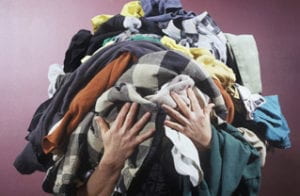 Since coming to NYU, I have lugged my huge duffel bags of clothing back and forth between my home state of California and New York. With every trip, I can’t help but think about the impact my four-closets worth of clothes have on both my sanity and the environment. Since my initial schlep, I have bought very few new clothing items. I recently went into a mall for the first time in years and I was immediately caught up in the uber-consumerism and “have-to-have-it” mentality that so many of us struggle with. However, I resisted the urge to buy anything other than the black jeans I had come for; something I hadn’t splurged on since sixth grade.
Since coming to NYU, I have lugged my huge duffel bags of clothing back and forth between my home state of California and New York. With every trip, I can’t help but think about the impact my four-closets worth of clothes have on both my sanity and the environment. Since my initial schlep, I have bought very few new clothing items. I recently went into a mall for the first time in years and I was immediately caught up in the uber-consumerism and “have-to-have-it” mentality that so many of us struggle with. However, I resisted the urge to buy anything other than the black jeans I had come for; something I hadn’t splurged on since sixth grade.
What’s even more burdensome than the physical weight of my oversized duffle bags, is the weight on my conscience of all of those many shoes, jeans, sweaters, and endless tops inside them. From the pesticides used for cotton farming and toxic dyes to the packaging and shipment of clothing products to retailers; the textile industry takes an enormous toll on the environment.
I must admit I am guilty of the occasional online shopping spree. Though the high price of shipping makes me think twice before clicking ‘order,’ often it’s just too convenient to resist. However when you order online, you have to consider not only the initial environmental effects in the farming, processing, manufacturing and distributing of the the products but also the additional environmental cost of packaging and shipping your individual order and the possibility of doubling these effects if you decide to return the item.
(Not so) fun facts about the clothing industry:
- It can take over 5,000 gallons of water to manufacture just a T-shirt and a pair of jeans.
- More than a half trillion gallons of fresh water are used in the dyeing of textiles each year. The dye wastewater is discharged, often untreated, into nearby rivers, where it reaches the sea, eventually spreading around the globe.
- While a majority of the world’s aggregate clothing corporations are based in the U.S., over 60 percent of world clothing is manufactured in developing countries.
- A single container ship used for transporting garments can produce as much cancer and asthma-causing pollutants as 50 million cars in just one year.
- In addition to carbon dioxide, nylon also emits a large amount of the greenhouse gas nitrous oxide, during manufacturing. The impact of one pound of nitrous oxide on global warming is almost 300 times that of the same amount of carbon dioxide, the most prominent greenhouse gas.
- The average New Yorker tosses 46 pounds of clothing and other textiles in the trash each year.
So, how do we break these detrimental consumer habits? Start by picturing your wardrobe. Now picture the clothes you actually wear on a regular basis. Minimizing your closet may not be as difficult as it sounds. Consider the Capsule Wardrobe Challenge. Minimize your wardrobe to 30 items or less. To really challenge yourself try 10 items for 1 month. Another option for those who just can’t kick the shopping addiction is to buy second-hand. By thrifting, you can still have new items in your wardrobe while reducing textile waste and the clothing industry’s negative impact on the environment.
If you are itching to empty out your closet after reading this article, a great option is to donate your textile waste to Grow NYC at the Greenmarket where they will sort and redistribute it to be worn or repurposed as mattress stuffing or industrial quality cloths. For more information and Greenmarket locations, visit www.GrowNYC.org/clothing.
Many of us have way more than we need and it’s not as hard as you may think to stay trendy without succumbing to the craze of consumerism. I am constantly trying to lessen the load of my duffle bags, and though I don’t intend to hand them all over to the Greenmarket at once, I have become much more conscious about buying new clothes. I always think to myself: what do I want and what do I really need?

Thanks, very good articles.
Very interesting
Those figures are alarming. I have a preschooler and even at her age I want to instill the importance of minimalism. We donated her old clothes, books and toys to charity. As much as possible we don’t buy a lot of clothes.